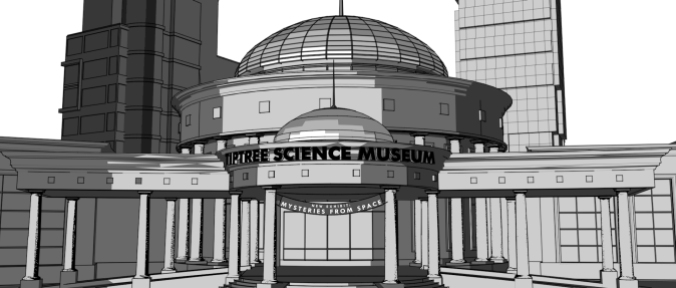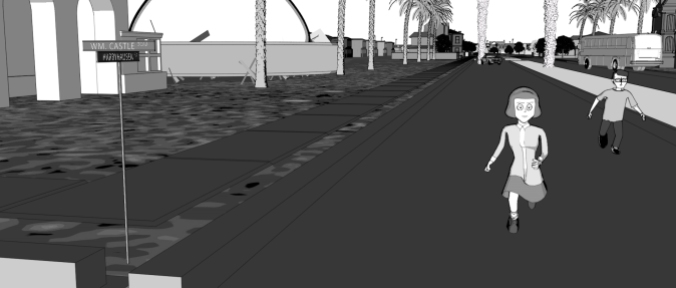We recently gave away a pair of autographed CDs over at the all-purpose geek-themed site Nerds of a Feather, Flock Together to people who correctly identified the most sci-fi and film references hidden in the animated video for our song Goodbye at the End of the World. But nobody was particularly close to getting all of them. There were a lot.
Now that the contest is over, it seemed like a good time to put together all the references in one place for those who might be interested. Let us know in the comments, on Facebook, or Twitter if one of your favorites made it into the background.
Robby the Robot, Forbidden Planet
Robby actually makes two appearances, one in small scale in the couple’s kitchen, and one in large scale in the museum. You can spot him in the background of each of these shots.
And for what it’s worth, in the museum shot you can also see the band’s old logo (itself an homage to the old RKO Studios logo) and the album cover against the wall.
Arthur Dent, The Hitchhiker’s Guide to the Galaxy
Although only the one shown above made it into the final video, the museum set has two exhibit halls, both named after characters from Douglas Adams’ The Hitchhiker’s Guide to the Galaxy: Arthur Dent, and Ford Prefect.
Vampira
Vampira, the iconic late-night horror TV show host from the 1950s who was the model for Disney’s Maleficent and was immortalized in one of my favorite movies, Ed Wood, was a persona created by the Norwegian model Maila Nurmi. The “V.” on the character’s museum ID card is for “Vampira.” I have a distant personal connection to Maila Nurmi, in that when she passed away in 2008 I helped buy her a headstone.
CRM-114, Dr. Strangelove and Others
Maila’s employee ID number is “CRM-114,” which is a designation that began life as the code device in Stanley Kubrick’s Dr. Strangelove: Or, How I Learned to Stop Worrying and Love the Bomb. Kubrick himself went on to reference this number in several other films, including 2001: A Space Odyssey, and since then many, many filmmakers have hidden nods to it in their movies. Like, for instance, Doc Brown’s giant amplifier rig in Back to the Future.
Speaking of…
The Time Machine, Back to the Future
Maila, or possibly her boyfriend Roger, drives the time machine, which is parked in the driveway.
Tiptree Science Musuem, Alice Bradley Sheldon
Alice Bradley Sheldon was a gifted science fiction writer who had to work under a male pen name in the 1950s because of awful gender stereotypes, and that pen name was James Tiptree, Jr. I thought a sci-fi video with a kick-ass female hero should work at a place named after a real-life sci-fi female hero. You can listen to a great radio story about Alice Sheldon here.
Gort’s, The Day the Earth Stood Still
In part, this video began with the idea “I wonder if I can make a giant robot step on a gas station?” Seemed a very 50s sci-fi thing to do. Like Robby the Robot, Gort is one of the signature robots of 1950s science fiction films, and appears in maybe the best genre movie of the era.
Bester Library, Alfred Bester
Alfred Bester wrote The Stars My Destination, which had a tremendous impact on me. As a matter of fact, as soon as I finished it, I put it down, picked up a guitar, and wrote the song “Gulliver Foyle,” the first track on the first Sci-Fi Romance album.
The library sits at the corner of…
Wm. Castle Blvd. and Harryhausen Drive
William Castle produced a number of great, schlocky B-movies, notably those with Vincent Price like The House on Haunted Hill, and maybe surprisingly, Rosemary’s Baby. Ray Harryhausen was a stop-motion animation master who brought hundreds of creatures to life and gave them personalities and soul you wouldn’t expect in films like 20 Million Miles to Earth.
Karloff’s at Le Moulin, Frankenstein
At the end of Frankenstein, which inspired the Sci-Fi Romance song “Frankenstein’s Lament,” also from the first album, Boris Karloff’s monster gets torched inside a windmill. Like Le Moulin Rouge, which was a restaurant and named after a windmill, I went for a little obvious symbolism.
Karloff’s performance is particularly meaningful to me, and it also inspired our song “The Bride of Frankenstein, 1935” from our October EP.
Crane Shot, Citizen Kane
These last two are probably the most pretentious, but when am I ever going to get the chance to tip my cap to these films ever again in quite the same way? So when the camera swoops through the domed ceiling of the museum, this is where that came from.
Final Shot, The Third Man
Like the stereotypical film school graduate I am, I love Orson Welles. But probably my favorite movie with him is one he didn’t direct, Carol Reed’s masterpiece The Third Man. I love it, and its final shot is, for me, one the most indelible ever.
Since I animated this thing myself, I had nobody to tell me I couldn’t be as self-indulgent as I pleased.














2 Responses